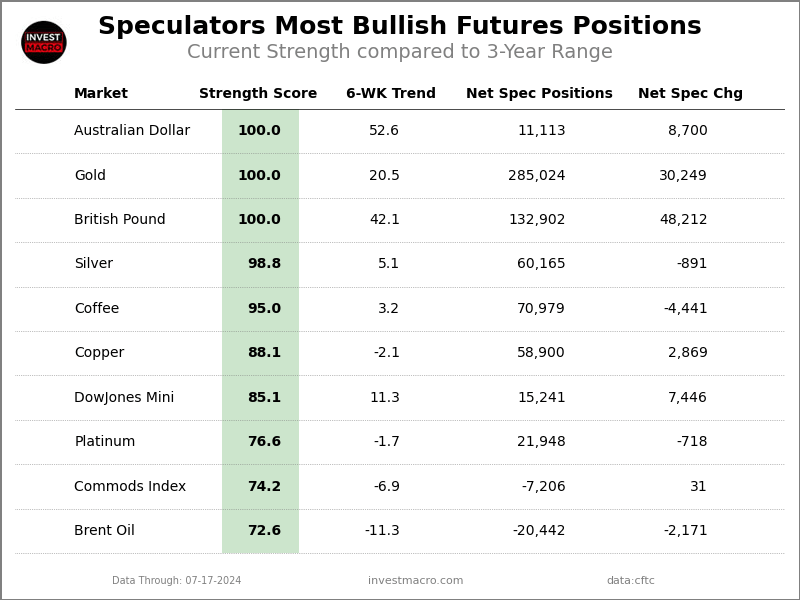

By InvestMacro
The latest update for the weekly Commitment of Traders (COT) report was released by the Commodity Futures Trading Commission (CFTC) on Friday for data ending on July 16th.
This weekly Extreme Positions report highlights the Most Bullish and Most Bearish Positions for the speculator category. Extreme positioning in these markets can foreshadow strong moves in the underlying market.
To signify an extreme position, we use the Strength Index (also known as the COT Index) of each instrument, a common method of measuring COT data. The Strength Index is simply a comparison of current trader positions against the range of positions over the previous 3 years. We use over 80 percent as extremely bullish and under 20 percent as extremely bearish. (Compare Strength Index scores across all markets in the data table or cot leaders table)


The Australian Dollar speculator position comes in as the most bullish extreme standing this week. The Australian Dollar speculator level is currently at a 100.0 percent score of its 3-year range.
The six-week trend for the percent strength score totaled 52.6 this week. The overall net speculator position was a total of 11,113 net contracts this week with a rise of 8,700 contract in the weekly speculator bets.
Free Reports:
Speculators or Non-Commercials Notes:
Speculators, classified as non-commercial traders by the CFTC, are made up of large commodity funds, hedge funds and other significant for-profit participants. The Specs are generally regarded as trend-followers in their behavior towards price action – net speculator bets and prices tend to go in the same directions. These traders often look to buy when prices are rising and sell when prices are falling. To illustrate this point, many times speculator contracts can be found at their most extremes (bullish or bearish) when prices are also close to their highest or lowest levels.
These extreme levels can be dangerous for the large speculators as the trade is most crowded, there is less trading ammunition still sitting on the sidelines to push the trend further and prices have moved a significant distance. When the trend becomes exhausted, some speculators take profits while others look to also exit positions when prices fail to continue in the same direction. This process usually plays out over many months to years and can ultimately create a reverse effect where prices start to fall and speculators start a process of selling when prices are falling.
The Gold speculator position comes next in the extreme standings this week. The Gold speculator level is now at a 100.0 percent score of its 3-year range.
The six-week trend for the percent strength score was 20.5 this week. The speculator position registered 285,024 net contracts this week with a weekly boost by 30,249 contracts in speculator bets.
The British Pound speculator position comes in third this week in the extreme standings. The British Pound speculator level resides at a 100.0 percent score of its 3-year range.
The six-week trend for the speculator strength score came in at 42.1 this week. The overall speculator position was 132,902 net contracts this week with a gain of 48,212 contracts in the weekly speculator bets.
The Silver speculator position comes up number four in the extreme standings this week. The Silver speculator level is at a 98.8 percent score of its 3-year range.
The six-week trend for the speculator strength score totaled a change of 5.1 this week. The overall speculator position was 60,165 net contracts this week with a small edge lower by -891 contracts in the speculator bets.
The Coffee speculator position rounds out the top five in this week’s bullish extreme standings. The Coffee speculator level sits at a 95.0 percent score of its 3-year range. The six-week trend for the speculator strength score was 3.2 this week.
The speculator position was 70,979 net contracts this week with a decrease of -4,441 contracts in the weekly speculator bets.
The 5-Year Bond speculator position comes in as the most bearish extreme standing this week. The 5-Year Bond speculator level is at a 0.0 percent score of its 3-year range.
The six-week trend for the speculator strength score was -0.2 this week. The overall speculator position was -1,576,174 net contracts this week with a dip by -9,573 contracts in the speculator bets.
The Brazil Real speculator position comes in next for the most bearish extreme standing on the week. The Brazil Real speculator level is at a 0.0 percent score of its 3-year range.
The six-week trend for the speculator strength score was -27.0 this week. The speculator position was -44,526 net contracts this week with a reduction by -1,842 contracts in the weekly speculator bets.
The Swiss Franc speculator position comes in as third most bearish extreme standing of the week. The Swiss Franc speculator level resides at a 0.0 percent score of its 3-year range.
The six-week trend for the speculator strength score was -6.8 this week. The overall speculator position was -49,793 net contracts this week with a drop of -3,705 contracts in the speculator bets.
The Cotton speculator position comes in as this week’s fourth most bearish extreme standing. The Cotton speculator level is at a 0.8 percent score of its 3-year range.
The six-week trend for the speculator strength score was -13.3 this week. The speculator position was -26,507 net contracts this week with a decline of -1,998 contracts in the weekly speculator bets.
Finally, the Corn speculator position comes in as the fifth most bearish extreme standing for this week. The Corn speculator level is at a 3.5 percent score of its 3-year range.
The six-week trend for the speculator strength score was -15.1 this week. The speculator position was -238,816 net contracts this week with an increase of 1,125 contracts in the weekly speculator bets.
Article By InvestMacro – Receive our weekly COT Newsletter
*COT Report: The COT data, released weekly to the public each Friday, is updated through the most recent Tuesday (data is 3 days old) and shows a quick view of how large speculators or non-commercials (for-profit traders) were positioned in the futures markets.
The CFTC categorizes trader positions according to commercial hedgers (traders who use futures contracts for hedging as part of the business), non-commercials (large traders who speculate to realize trading profits) and nonreportable traders (usually small traders/speculators) as well as their open interest (contracts open in the market at time of reporting). See CFTC criteria here.
By JustMarkets On Tuesday, the Dow Jones (US30) Index was down 0.03%. The S&P 500…
By RoboForex Analytical Department The EUR/USD pair continues its gradual decline, erasing its recent technical…
By ForexTime Trump set to announce “reciprocal” tariffs on Wednesday, April 2nd. Markets fear worst-case…
By JustMarkets On Monday, the Dow Jones (US30) rose by 1.00%. The S&P 500 Index…
By JustMarkets At the end of Friday, the Dow Jones Index (US30) fell by 1.69%…
By InvestMacro Here are the latest charts and statistics for the Commitment of Traders (COT)…
This website uses cookies.